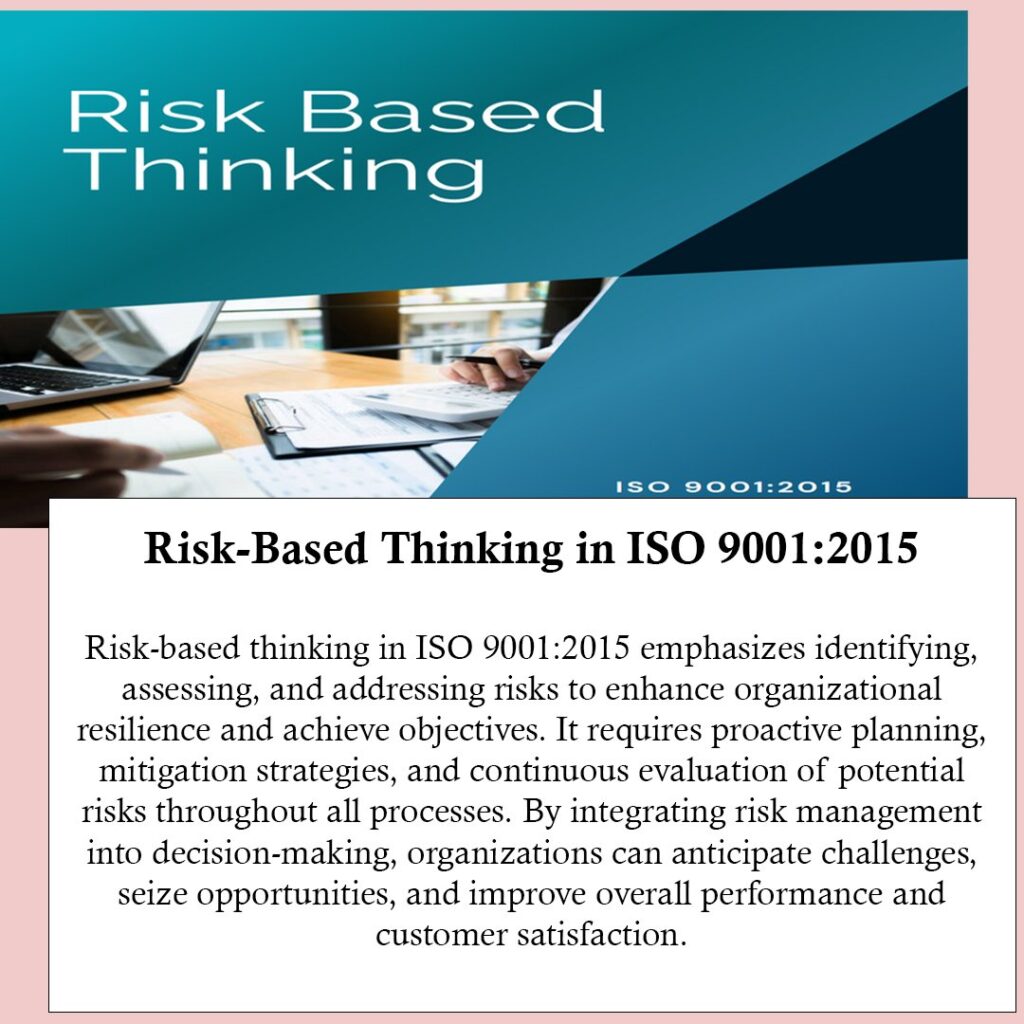Subtotal $0.00

Risk-based thinking is a fundamental concept within ISO 9001:2015, the international standard for Quality Management Systems (QMS). It emphasizes proactive identification, assessment, and mitigation of risks to enhance organizational resilience, improve decision-making, and achieve better outcomes. This guide explores the principles of risk-based thinking and practical strategies for implementing effective risk management within the framework of ISO 9001:2015.
Understanding Risk-Based Thinking
Definition: Risk-based thinking involves considering risks and opportunities throughout the organization’s processes, from strategic planning to operational execution. It encourages a proactive approach to identify potential risks that could affect the achievement of objectives and opportunities that could lead to improvement.
Integration with QMS: In ISO 9001:2015, risk-based thinking is integrated into various clauses of the standard, including context of the organization, leadership, planning, support, operation, performance evaluation, and improvement. It shifts the focus from reactive problem-solving to proactive risk management, aligning with the organization’s context and strategic direction.
Principles of Risk-Based Thinking
Proactive Approach:
Anticipate Challenges: Identify potential risks early in processes and activities to prevent issues before they occur.
Seize Opportunities: Recognize opportunities for improvement and innovation that can enhance organizational performance and competitiveness.
Systematic Process:
Structured Approach: Implement a structured process for risk management, including risk identification, assessment, mitigation, and monitoring.
Continuous Improvement: Continually assess and adapt risk management processes to reflect changing internal and external contexts.
Key Elements of Risk Management
Risk Identification:
Process Mapping: Map out organizational processes and activities to identify potential sources of risk.
Brainstorming Sessions: Conduct brainstorming sessions with stakeholders to identify both internal and external risks.
Risk Assessment:
Probability and Impact: Evaluate the likelihood of risks occurring and their potential impact on organizational objectives.
Risk Prioritization: Prioritize risks based on their significance and the organization’s ability to manage and mitigate them effectively.
Risk Mitigation:
Control Measures: Implement control measures to mitigate identified risks, reducing their likelihood or impact.
Contingency Planning: Develop contingency plans to respond to unexpected events or risks that materialize.
Implementing Risk-Based Thinking in ISO 9001:2015
Organizational Context:
Understanding Context: Determine the internal and external factors that impact the organization’s ability to achieve its objectives.
Risk Appetite: Define the organization’s risk appetite and tolerance levels, guiding risk management decisions.
Leadership and Commitment:
Top Management Involvement: Demonstrate leadership commitment to risk-based thinking by integrating it into strategic planning and decision-making.
Resource Allocation: Allocate resources, including time, budget, and personnel, to support effective risk management activities.
Operational Planning:
Operational Controls: Implement controls and procedures that address identified risks and opportunities in daily operations.
Training and Awareness: Provide training to employees on risk-based thinking principles and their roles in managing risks within their areas of responsibility.
Benefits of Risk-Based Thinking
Enhanced Decision-Making:
Informed Decisions: Use risk assessments to make informed decisions that consider potential outcomes and consequences.
Risk-Informed Planning: Integrate risk considerations into strategic and operational planning processes, enhancing the organization’s ability to achieve objectives.
Improved Performance and Efficiency:
Preventive Action: Proactively address risks before they impact performance or lead to non-conformities.
Optimized Resource Allocation: Allocate resources more efficiently by focusing on areas with higher risks or opportunities for improvement.
Organizational Resilience:
Adaptability: Increase organizational resilience by anticipating and preparing for potential risks and disruptions.
Continuous Improvement: Foster a culture of continuous improvement through lessons learned from managing risks and seizing opportunities.
Challenges of Implementing Risk-Based Thinking
Cultural Shift:
Mindset Change: Overcome resistance to change and foster a culture that values proactive risk management.
Training and Awareness: Educate employees on the benefits of risk-based thinking and their role in its successful implementation.
Resource Constraints:
Resource Allocation: Address challenges related to allocating sufficient resources, including time and expertise, for effective risk management.
Integration with Existing Systems: Integrate risk-based thinking with existing management systems and processes to avoid duplication or inefficiencies.
Continuous Improvement and Review
Monitoring and Review:
Performance Evaluation: Monitor the effectiveness of risk management activities and adjust strategies as needed.
Management Review: Conduct periodic management reviews to evaluate the integration of risk-based thinking into QMS processes and identify areas for improvement.
Feedback and Adaptation:
Learning Organization: Encourage a learning culture where feedback from risk management activities informs future decisions and actions.
Benchmarking: Benchmark risk management practices against industry standards and best practices to drive continuous improvement.
Certification and External Audits
Certification Preparation:
Audit Readiness: Prepare for certification audits by documenting risk management processes, outcomes, and improvements.
Evidence of Compliance: Provide evidence of effective risk-based thinking and its integration into the QMS during external audits.
Case Studies and Practical Examples
Industry Examples:
Manufacturing Sector: Implement risk-based thinking to enhance product quality, supply chain resilience, and customer satisfaction.
Service Industries: Apply risk management principles to improve service delivery, customer retention, and operational efficiency.
Conclusion
Implementing risk-based thinking within ISO 9001:2015 enables organizations to proactively manage risks, seize opportunities, and enhance overall performance and resilience. By embedding risk management principles into strategic and operational processes, organizations can improve decision-making, optimize resource allocation, and foster a culture of continuous improvement. Leadership commitment, effective implementation strategies, and a systematic approach to risk management are essential for leveraging the benefits of risk-based thinking and achieving sustained success under ISO 9001:2015.